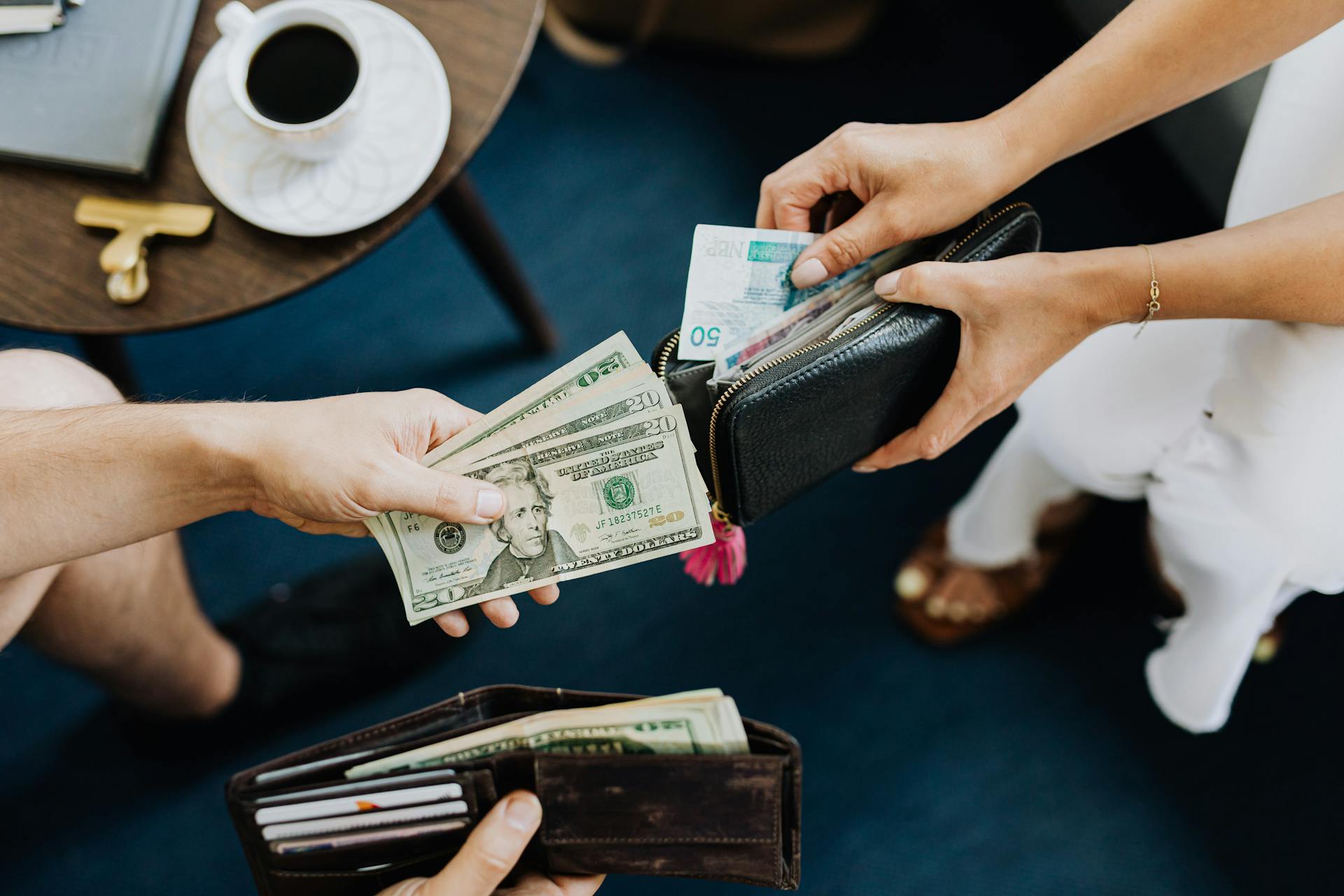
A medium of exchange is a fundamental concept in economics that enables individuals and businesses to trade goods and services with each other.
It facilitates the exchange of value, allowing people to get what they need without having to barter directly.
The first known medium of exchange was commodity money, which was used in ancient civilizations such as the Lydians around 560 BCE.
The Lydians used gold and silver coins as a medium of exchange, which marked the beginning of a standardized currency system.
The introduction of paper money in China during the Tang Dynasty in 771 CE revolutionized the medium of exchange, making it more convenient and widely available.
Fiat currency, which is currency that has value because the government says so, was introduced in the 20th century, further changing the medium of exchange landscape.
Consider reading: Where Are Dinars Used
What Is Currency?
Currency is a medium of exchange that represents a standard of value in modern economies.
It's widely accepted by all parties involved in a transaction.
In fact, currency is used to facilitate the purchase and sale of goods and services between parties.
Gold has also served as a medium of exchange throughout history, but currency is the primary standard in modern economies.
On a similar theme: Artistic Medium Apex
Characteristics
A medium of exchange is durable, meaning it's meant to last longer and not go anywhere any time soon. In fact, its durability is one of the key characteristics that make it suitable for exchange.
To be a good medium of exchange, an object must be portable, which means it can be easily carried wherever one wants. This is crucial for facilitating transactions between parties.
A medium of exchange must also be acceptable to the parties involved in the transaction. This means they must mutually agree to accept it for the dealing.
It's also important for a medium of exchange to be divisible if required. This allows for easy conversion of the medium into smaller units, making it easier to use in transactions.
Here are the key characteristics of a medium of exchange:
- Durable: able to withstand repeated use.
- Portable: easily carried and transported.
- Acceptable: most people must accept the medium as payment.
- Divisible: divisible to small units.
- Scarce: its supply in circulation must be limited.
Creation and Supply
Money supply is the number of financial instruments within an economy available for purchasing goods or services, measured by adding together various financial instruments such as currency, demand deposits, and other types of deposits.
Economists employ different ways to measure the stock of money or money supply, using a categorization system that focuses on the liquidity of the financial instrument used as money. This system includes monetary aggregates M1, M2, and M3, which are successively larger aggregate categories.
The majority of money is created as M1/M2 by commercial banks making loans, which forms the largest part of broad money in developed countries.
History
The concept of money has been around for thousands of years, and it's fascinating to explore its history.
The first known standardized medium of exchange was a coin issued about 2,600 years ago in Lydia, an ancient kingdom in what is now western Turkey.
It was made of a gold and silver alloy, stamped with an official government image, and had a guaranteed weight and purity.
The Lydians were the first known to issue it in a standardized form that could be accepted as having a set value.
Readers also liked: Currency Also Known as the Renminbi Crossword
In fact, the Lydian coin is considered one of the earliest examples of a commodity accepted by general consent as a medium of exchange.
In modern economies, the local currency is the universal medium of exchange, except in dire economic circumstances.
For example, in Germany directly after World War II, cigarettes or cognac were used as a medium of exchange due to the economic situation.
Readers also liked: Money Is Medium of Exchange
Creation of
Money creation is a fascinating topic, and it's essential to understand how it works. In current economic systems, money is created by two main procedures.
Legal tender, also known as narrow money (M0), is the cash created by a Central Bank by minting coins and printing banknotes. This is the only money that can satisfy the reserve requirements of commercial banks.
Bank money, or broad money (M1/M2), is the money created by private banks through the recording of loans as deposits of borrowing clients. This type of money forms the largest part of broad money in developed countries.
Banks don't simply act as intermediaries, lending out deposits that savers place with them. Instead, they create new loans and deposits, which is contrary to some popular misconceptions.
In most countries, the majority of money is created as M1/M2 by commercial banks making loans. This means that the value of money exists on the books of financial institutions and can be converted into physical notes or used for cashless payment.
Types of Currency
Currency is a standardized financial instrument that the government issues to facilitate trade and exchange within a country. It's a legal tender that bears the assurance of paying the value as printed on the note.
Alternative currencies, like company scrip, have appeared throughout time during periods of economic duress to spur commerce or buttress a national currency. They're little more than an IOU and depend on the reputation of the issuer for their acceptability as a form of payment.
National currency, like the dollar, is the most powerful circulating medium. It's a standard of valuation of all other currencies of the world as it is the most stable and powerful currency in the world.
- National Currency
- Hard Currency
- Currency Pair
Precious metals, such as gold and silver, have been successfully used as money in many societies. They were a good medium of exchange due to their value, divisibility, and difficulty to counterfeit.
Commercial Bank
Commercial banks have a unique way of creating money, known as fractional-reserve banking. This means that they only hold a fraction of their deposits in reserve, rather than keeping all of them.
One of the key characteristics of commercial bank money is that it's non-physical, existing only in the account ledgers of banks and other financial institutions. This makes it different from commodity and fiat money.
Commercial bank money is created when banks make loans to their customers, which increases the amount of money in circulation. The money multiplier theory explains how this process works, taking into account factors such as reserve requirements and business policies.
Related reading: Pakistan Foreign Currency Reserves
The central bank doesn't directly control the creation of commercial bank money, but its interest rate-setting policies can influence the amount of loans and deposits that banks create.
Here are some key differences between commercial bank money and other types of currency:
Commercial bank money differs from commodity and fiat money in two key ways: it's non-physical and there's some risk that the claim won't be fulfilled if the financial institution becomes insolvent.
Alternative Example
In 1907, a series of bank failures led to widespread cash shortages, prompting companies to issue their own scrip and emergency currency to pay their workers.
Workers could redeem this scrip for food and services or hold onto it for future redemption.
Company scrip and emergency currency are informal money substitutes that depend on the reputation of the issuer for their acceptability.
The value of BerkShares, a local currency launched in 2006, is pegged to the value of the US dollar but issued at a discount.
Readers also liked: Colonial Scrip
BerkShares can be obtained at participating bank branches in exchange for US dollars at a rate of 95 cents.
A cocoa grower in Africa might use gold coins as a circulating medium to exchange for tea with an American buyer.
Gold coins were a good medium of exchange due to their known value, divisibility, and difficulty to counterfeit.
They were also considered a good store of wealth, as they were not perishable goods and maintained their value due to people's expectations.
The most powerful circulating medium is the US dollar, which is a standard of valuation for all other currencies.
Here are some examples of alternative currencies:
- National Currency
- Hard Currency
- Currency Pair
Market and Liquidity
Market and liquidity go hand in hand when it comes to trading goods and services. Money is the most liquid asset because it's universally recognized and accepted as a common currency.
Liquid financial instruments are easily tradable and have low transaction costs. This means there should be no (or minimal) spread between the prices to buy and sell the instrument being used as money.
The concept of market liquidity is crucial in facilitating trade. It gives consumers the freedom to trade goods and services easily without having to barter.
Here are some examples of mediums of exchange:
Money's liquidity is a fundamental aspect of trade. It's what makes it possible for people to exchange goods and services without having to barter.
Examples and Explanation
Local currencies like BerkShares have shown that alternative mediums of exchange can be effective in promoting economic growth and sustainability in a region. BerkShares, launched in 2006, is accepted by some 350 businesses in the Berkshires region of Massachusetts.
The value of BerkShares is pegged to the dollar but issued at a discount, making it a reliable and widely accepted medium of exchange. BerkShares can be obtained at participating bank branches for a rate of 95 cents.
In a barter system, finding a buyer who wants the same goods in exchange can be difficult, as seen in the example of the cocoa grower in Africa. The cocoa grower struggled to find a buyer for her product.
A common circulating medium like gold coins can solve this problem, as it has buying power worldwide and is widely accepted. The American buyer and African seller in the example settled on gold coins as a medium of exchange.
Local currencies like BerkShares offer a more practical solution, as they are designed to be used in a specific region and are backed by local businesses. Participating businesses in the Berkshires region accept BerkShares as a form of payment.
Readers also liked: Gold for Bitcoins
Frequently Asked Questions
What are the 4 mediums of exchange?
The 4 main mediums of exchange are commodity money, representative money, cryptocurrency, and fiat money. These mediums of exchange can take various forms, including digital and physical tokens like coins and notes.
What is the best medium of exchange?
The best medium of exchange is money, which facilitates trade by eliminating the inefficiencies of bartering. It enables smooth transactions and promotes economic growth.
Featured Images: pexels.com


